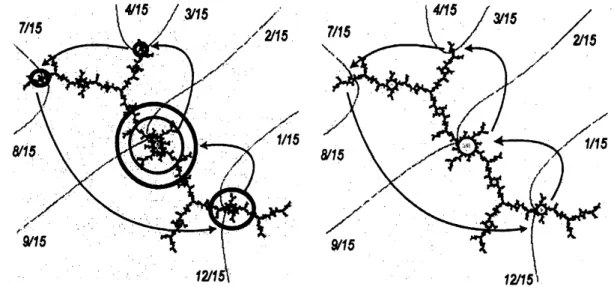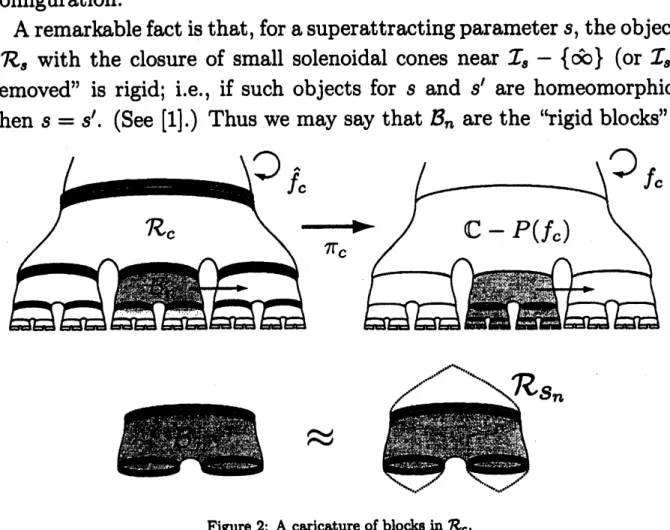Rigidity
of
Riemann surface laminations
associated with
infinitely
renormalizable
quadratic
maps
*Tomoki Kawahira
\dagger (Nagoya
University)川平 友規 (名古屋大学・多元数理)
Abstract
In this note we describe the well studied process of renormalization of
quadratic polynomials from the viewpoint of their associated Riemann
sur-face laminations. The main result is that, when an infinitely renormalizable
quadratic map has a-priori bounds, the topology of the lamination is rigid
modulo its combinatorial equivalence. This is ajoint work with C. Cabrera
(University ofWarwick).
1 Renormalization and
its
combinatoricsQuadratic-like maps. Let $U$ and $V$ be topological disks in $\mathbb{C}$ with $U$ compactly contained in $V$
.
A
quadratic-like map $g$ : $Uarrow V$ isa
proper
holomorphic map of degree two. Thefilled
Julia set is defined by$K(g)$ $:= \bigcap_{n\geq 1}g^{-n}(V)$
.
In
thisnote
we
assume
thatany
quadratic-likemap
$g$ : $Uarrow V$ hasa
connected
$K(g)$; equivalently,the forward
orbitof
thecritical
pointis
contained in $K(g)$
.
$1$We define the postcpitical set $P(g)$ by the closure
of the forward orbit of the critical polnt.
By the Douady-Hubbard straightening theorem, there exists
a
unique$c=c(g)\in \mathbb{C}$ and
a
quasiconformal map $h$ : $Varrow V’$such
that $h$conjugates $g:Uarrow V$ to $f_{c}$ : $U’arrow V’$ where $U’=h(U)=f_{c}^{-1}(V’)$ and
$\overline{\partial}h=0$
a.e.
on
$K(g)$.
The quadratic map $f_{c}$ is called the straighteningof $g$ and $h$ is called
a
straightening map. Though suchan
$h$ is notuniquely determined,
we
alwaysassume
that any quadratic-like map $g$is accompanied by
one
fixed straighteningmap
$h=h_{g}$.
$Thk$not6 il$ba\epsilon Qd$on$r$talk
$61k$
atRIMS,atRIMS,6$S\cdot p$. 2007. $\uparrow R\epsilon e\cdot rch$partially supportedbyJSPS.Renormalization of quadratic maps. A quadratic-like map $g$ :
$Uarrow V$ is said to be renormalizable, if there exist
a
number $m>1$ ,called the order
of
renormalization, and two open sets $U_{1}\subset U$ and$V_{1}\subset V$ containing the critical point of $g$, such that $g_{1}=g^{m}|U_{1}arrow V_{1}$ is
again
a
quadratic-like map with connectedfilled
Julia set $K_{1}$ $:=K(g_{1})$.
We also
assume
that $m$ is the minimalorder
with this property and that $K_{1}$ has the following property: For any $1\leq i<j\leq m,$ $g^{i}(K_{1})\cap$ $g^{j}(K_{1})$ is emptyor
justone
point that separates neither $g^{i}(K_{1})$nor
$g^{j}(K_{1})$.
(Sucha
renormalization is called simpleor
non-crossing.)Superattracting parameters associated with renormalizations.
For any (simple) renormalization $g_{1}=g^{m}$ : $U_{1}arrow V_{1}$ of $g:Uarrow V$, the
combinatorialproperty of$g_{1}$ within the dynamics of$g$ is represented by
a
uniquely determined superattracting quadratic map $f_{s}(z)=z^{2}+s$ with $s=s(g, g_{1})$ and $f_{s}^{m}(0)=0$
.
(Roughly put, the dynamics of$g$ is given bythe dynamics of $f_{s}$ with its $m$ periodic Fatou components replaced by $m$
small copies of $K_{1}=K(g_{1}).)$
More precisely,
we
can
determine $s(g, g_{1})$as
follows: Wecan
definethe $\beta- fixed$ point $\beta_{1}$ of quadratic-like map $g_{1}$ (not g) by pulling back
the $\beta- fixed$ point (the landing point of the external ray of angle $0$) of
quadratic map $f_{c_{1}}$ with $c_{1}=c(g_{1})$ via straightening map $h_{1}=h_{g_{1}}$
.
Thenthe forward orbit of$\beta_{1}$ by the dynamics of$g$ gives
a
repellingor
paraboliccycle $O$
.
Next by the straightening map $h=h_{g}$,we can
send the cycle $O$to the cycle $h(O)$ of $f_{c}$ with $c=c(g)$
.
The set of angles of external raysthat land
on
$h(O)$ is called the ray portrait of $h(O)$.
There isa
fact thatthe ray portrait determines
a
unique superattracting parameter $s$ suchthat the boundaries
of
the periodic Fatou components of $f_{s}$ containa
repelling cycle $O_{s}$ with the
same
orbit portraitas
$h(O)$.
Nowwe
define$s(g, g_{1})$ by this $s$
.
(Conversely, superattracting parameter $s$ uniquelydetermines such
an
orbit portrait. See Milnor’s [6])Example. The diagram in the left of Figure 1 shows
a
quadratic-like map
$g_{1}$as a
renormalization
of $g=f_{c}$ with $c\approx-0.1539+1.0377i$.
(In this
case
we
regard $g$as a
restriction of the quadratic map $f_{c}$on a
The $\beta- fixed$ point of $g_{1}$ is the landing point of the external rays of
angles 2/15 and 9/15 for $g=f_{c}$
.
In thiscase
the orbit portrait is$\{\{9/15,2/15\}, \{3/15,4/15\}, \{6/15,8/15\}, \{12/15, 1/15\}\}$
.
The diagram in the right shows the corresponding superattracting
dy-namics $f_{\epsilon}$ with $s=s(g, g_{1})\approx-0.15652+1.03225i$
,
which satisfies$f_{s}^{4}(0)=0$
.
Figure 1: Anysimplerenormalizatlon determlnes aunique superattractingparameter.
Inflnitely renormalizable maps and
its
combinatorIcs. Wesay
$f_{c}$ is infinitely renomalizable if there isan
infinite sequence of numbers$p_{0}=1<p_{1}<p_{2}<\cdots$ and two
sequences of open
sets $\{0\in U_{n}\}$ and$\{V_{n}\}$ such that each $g_{n}=f_{c}^{p_{n}}$ : $U_{n}arrow V_{n}$ is
a
quadratic-like map, withthe property that $g_{n}’(0)=0$ and $g_{n+1}$ is
a
simple renormalization of $g_{n}$of order $m_{n}$ $:=p_{n+1}/p_{n}>1$
.
The index $n$ of $g_{n}$ is called the level ofrenormalization.
For such
an
$f_{c}$, the sequenoe $\{g_{n} : U_{n}arrow V_{n}\}_{n\geq 0}$ uniquely determinesthe infinite sequence of superattracting parameters $\{s_{0}, s_{1}, s_{2}, \ldots\}$ given
by $s_{n}=s(g_{n}, g_{n+1})$
.
We denote the sequence $\sigma(c)$ and call it thecombi-natorics of $f_{c}$
.
For example, the Feigenbaum parameter $c=$
-1.4011552..
hascom-binatorics $\sigma(c)=\{-1, -1, -1, . . ,\}$, since
every
level of renormalization2 Inverse limits, natural extensions, and regular parts
Inverse Limits. Consider $\{f_{-n} : X_{-n}arrow X_{-n+1}\}_{n=1}^{\infty}$,
a sequence
of
d-tol
branched covering mapson
the manifolds $X_{-n}$ with thesame
dimension.
The inverse limit of thissequence
isdefined
as
$\lim_{arrow}(f_{-n}, X_{-n})$
$;= \{\hat{x}=(x_{0}, x_{-1}, x_{-2}\ldots)\in\prod_{n\geq 0}X_{-n} : f_{-n}(x_{-n})=x_{-n+1}\}$
.
The space $\lim_{arrow}(f_{-n}, X_{-n})$ has
a
natural topology which is induced fromthe product topology in $\prod X_{-n}$
.
The projection $\pi$:
$\lim_{arrow}(f_{-n}, X_{-n})arrow X_{0}$is
defined
by $\pi(\hat{x})$ $:=x_{0}$.
Example 1: Natural extensions ofquadratic maps. When all the pairs $(f_{-n}, X_{-n})$ coincide with the quadratic $(f_{c},\overline{\mathbb{C}})$, following Lyubich
and Minsky [5],
we
willdenote
$\lim_{arrow}(f_{c},\overline{\mathbb{C}})$ by $N_{c}$.
The set
$N_{c}$ iscalled
the natural extension of $f_{c}$
.
In thiscase
we
denote the projection by $\pi_{c}$ : $\mathcal{N}_{c}arrow\overline{\mathbb{C}}$.
There isa
natural homeomorphic action$\hat{f}_{c}$ : $\mathcal{N}_{c}arrow \mathcal{N}_{c}$
given by $\hat{f}_{c}(z_{0}, z_{-1}, \ldots)$ $:=(f_{c}(\triangleleft), z_{0}, z_{-1}, \ldots)$
.
Then $\pi_{c}$ semiconjugatesthe action of $\hat{f}_{c}$
:
$\mathcal{N}_{c}arrow \mathcal{N}_{c}$ to $f_{c}$:
$\overline{\mathbb{C}}arrow\overline{\mathbb{C}}$.
Example 2: Dyadic solenoid and solenoidal
cones.
A well-knownexample of
an
inverse limit is the dyadic solenoid $S^{1}$$:= \lim_{arrow}(f_{0},S^{1})$,
where $f_{0}(z)=z^{2}$ and $S^{1}$ is the unit circle in $\mathbb{C}$
.
The dyadic solenoid isa
connected set but is not path-connected. Any space homeomorphic to$\lim_{arrow}$($f_{0}$, C–ID) will be called
a
solenoidalcone.
For $f_{c}$ with connectedfilled Julia set $K(f_{c})$,
we
havean
important example ofa
solenoidalcone
$\lim_{arrow}(f_{c},\overline{\mathbb{C}}-K(f_{c}))$ in$\mathcal{N}_{c}$ by looking at
$\lim_{arrow}$($f_{0}$,C-D) through the inverse B\"ottcher coordinate $\psi_{c}^{-1}$
:
$\overline{\mathbb{C}}-\overline{D}arrow\overline{\mathbb{C}}-K(f_{c})$.
One
can
also finda
solenoidal
cone
inany
neighborhood of $\infty=\wedge\{\infty, \infty, \infty\}$ in $\mathcal{N}_{c}$.
Example 3: Quadratic-like inverse limits. Let $g$ : $Uarrow V$ be
a
quadratic-likemap.
By $\lim_{arrow}(g, V)$we
denote the inverse limit for thesequence
$arrow g^{-2}(V)arrow g^{-1}(V)=Uarrow V$
.
By using the Douady-Hubbard straightening, it is not difficulttoprove this
Proposition 1.
Let
$g:Uarrow V$ bea
quadratic-like map with straighten-ing $f_{c}(z)=z^{2}+c$.
Then the inverse limit $\varliminf(g, V)$ is homeomorPhic
to $\mathcal{N}_{c}$ with a compact solenoidalcone
at infinity removed.Regular parts of quadratic natural extensions. Let $f_{c}$ be
a
quadratic map.
A
point $\hat{z}=(z_{0}, z_{-1}, \ldots)$ in the natural extension $\mathcal{N}_{c}=$$\lim_{arrow}(f_{c},\overline{\mathbb{C}})$ is regular if
there
isa
neighborhood $U_{0}$of
$z_{0}$ suchthat the
pull-back of $U_{0}$ along $\hat{z}$ is eventually univalent. The regular part(or regular
leaf
space) $\mathcal{R}_{f_{c}}=\mathcal{R}_{c}$ is the set of regular points in $\mathcal{N}_{c}$.
Let$\mathcal{I}_{f_{C}}=\mathcal{I}_{c}$
denote the set of irregular points.
The regular part is analytically well-behaved part
of
the naturalex-tensions. For example, it is known that all path-connected components
(leaves’) of $\mathcal{R}_{c}$
are
isomorphic to $\mathbb{C}$or
D. Moreover, $\hat{f}_{c}$ sends leaves toleaves isomorphically. However, most of such leaves
are
wildly foliatedin
the natural
extension, indeed dense in $\mathcal{N}_{c}$.
See
[5,\S 3]
formore
details.
Example: Regular part of superattracting
maps.
Let $f_{s}$ bea
superattracting quadratic map with superattracting cycle
$\{\alpha_{s}(1), \ldots, \alpha_{s}(m)=0\}$
.
Under the homeomorphic action $\hat{f}_{s}$ : $\mathcal{N}_{s}arrow \mathcal{N}_{s}$, the points
$\hat{\alpha}_{s}(i)$ $;=(\alpha_{s}(i), \alpha_{s}(i-1),$ $\alpha_{s}(i-2),$
$\ldots$)
form
a
cycleof
period $m$.
In this case, the set $\mathcal{I}_{s}$of
irregular pointsconsists of $\{\infty\wedge, \hat{\alpha}_{s}(1), \ldots,\hat{\alpha}_{s}(m)\}$
.
Thus the regular part $\mathcal{R}_{s}$ is $\mathcal{N}_{s}$ minusthese $m+1$ irregular points. Moreover, it is known that $\mathcal{R}_{s}$ is
a
Riemannsurface
lamination with all leaves isomorphic to $\mathbb{C}$.
3 Main Results
Regular part of inflnitely renormalizable maps.
An
infinitelyrenormalizable
$f_{c}$ is said to have a-priortbounds
if there exist $\eta>0$,independent
of
$n$,
such that mod$(V_{n}\backslash U_{n})>\eta$.
In thiscase
the nesteddomains
of infinite renormalizations
nicelyshrink and
the“remained”
The following is due to
Kaimanovich
and Lyubich [3]2:
Theorem 2 (Riemann surface lamination).
If
$f_{c}$ has $a- prio\dot{n}$ bounds,then $\mathcal{R}_{c}$ is
a
locally compact Riemannsurface
lamination, whose leavesare
conformally isomorphic to planes.The local compactness is important when
we
consider its endcom-pactification in the proofofTheorem 4. It is also known that there exist
quadratic maps with locally non-compact regular parts.
In addition to the theorem above,
we
can
show that suchan
$\mathcal{R}_{c}$can
bedecomposed into “blocks” which
are
given by combinatoricsdetermined
by the sequence of renormalization:
Theorem 3 (Structure Theorem, [2]). Let $f_{c}$ be infinitely
renomal-izable with
a
Priori
bounds and $\{g_{n}=f_{c}^{p_{n}}|U_{n}arrow V_{n}\}_{n\geq 0}$ be the associatedsequence
of
renormalizations with combinatorics$\sigma(c)=\{s_{0}, s_{1}, \ldots\}$.
Set
$m_{n}$ $:=p_{n+1}/p_{n}$
.
Then there exist disjoint open 8ubsets $\mathcal{B}_{0},$ $\mathcal{B}_{1},$$\ldots$
of
$\mathcal{N}_{c}$
such that:
1.
For
$n=0$, theset
$\mathcal{B}_{0}$ is homeomorphic to $\mathcal{R}_{s0}$ with the closureof
small solenoidal
cones
near
$\mathcal{I}_{\epsilon_{0}}-\{\wedge\infty\}$ removed.2. For each $n\geq 1$, the set $\mathcal{B}_{n}$ is homeomorphic to $\mathcal{R}_{\epsilon_{n}}$ with the closure
of
small solenoidalcones near
$\mathcal{I}_{s_{n}}$ removed.3.
Forany
$n\geq 1$ and $1\leq i<j\leq p_{n}$, thesets
$\hat{f}_{c}^{i}(\mathcal{B}_{n})$ and $\hat{f}_{c}^{j}(\mathcal{B}_{n})$are
$di8joint$
.
4.
For $0\leq n<n’$, the closures $\overline{\mathcal{B}_{n}}$ and $\overline{\mathcal{B}_{n’}}$ intersectsiff
$n’=n+1$.
In this case,
for
all $0\leq i\leq m_{n}-1$ the closures $\hat{f}_{c}^{p_{n}}{}^{t}(\mathcal{B}_{n+1})$ and $\overline{\mathcal{B}_{n}}$share just
one
of
their solenoidal boundary components.5. The set $\mathcal{B}_{0}\cup\bigcup_{n=1}^{\infty}\bigcup_{i=0}^{p_{n}-1}\overline{\hat{f}_{c}^{1}(\mathcal{B}_{n})}$ is equal to the regular part $\mathcal{R}_{c}$
.
6. The
original natural extension is given by $\mathcal{N}_{c}=\mathcal{R}_{c}uP(f_{c})u\wedge\{\infty\wedge\}$,–
where$P(f_{c})$ is the set
of
thebackward
orbits remain in the postcriticalsseett $P(f_{c})$
.
2Thistheorem and$Th\infty r\cdot m3$areoriginally provedunderpersiste$nt$recurrence;thatis, for anyneighborhood$U0$of
$z_{0}E$(the$p$utcriticalset) and anybackward orbit$2=(z_{0}, z_{-1}, \ldots)$,the$pull\cdot back8$of$U_{0}$ along$z_{0}$ contalnsthecritical
See Figure 2. Theopen sets $\mathcal{B}_{n},\hat{f}_{c}(\mathcal{B}_{n}),$ $\cdots$ , $\hat{f}_{c}^{p_{\mathfrak{n}}-1}(\mathcal{B}_{n})$form the “block”
oflevel $n$
.
The theorem says that the regular part $\mathcal{R}_{c}$ isa
tree-likestruc-ture which consists of the blocks $\{\hat{f}_{c}^{i}(\mathcal{B}_{n})$ : $n\geq 0,0\leq i<p_{n}\}$
.
Onemay compare
this tree-like object with the Riemann surface $\mathbb{C}-P(f_{c})$,where the postcritical set $P(f_{c})$ is
a
Cantor set.
They have thesame
configuration.
A remarkable fact is that, for
a
superattracting parameter $s$,
theobject$\mathcal{R}_{s}$ with the closure of small solenoidal
cones
near
$\mathcal{I}_{s}-\{\wedge\infty\}$ (or $\mathcal{I}_{s}$)removed” is rigid; i.e., if such objects for $s$ and $s’$
are
homeomorphic,then $s=s’$
.
(See [1].) Thuswe
may say that $\mathcal{B}_{n}$are
the “rigid blocks”.$\approx$
Figure 2: A caricature of blocks in$\mathcal{R}_{c}$
.
Remark also that the statement of Theorem 3 is quite topological. For
instance, the block $\mathcal{B}_{n}$ which
we
will constructmay
not bean
invariantset of $\hat{f}_{c}^{p_{n}}$
.
Nevertheless,we can
prove that the topology of $\mathcal{R}_{c}$ givenby such blocks determines the original dynamics modulo combinatorial
equivalence:
Theorem 4 (Rigidity
up
tocombinatorial
equivalence, [2]). Let $c$be
a
non-real
complex number,such
that the map $f_{c}$ is infinitelyrenor-malizable
with a-prtori bounds.If
there enistsan
orientation
$p$re
servingcombi-natorial class; $i.e.,$ $\sigma(c)=\sigma(c’)$
.
This implies that the topology ofthe regularpart determines the
com-binatorics
of the map. It is conjectured that for any infinitelyrenormal-izable $c$ and $c’$,
if
$\sigma(c)=\sigma(d)$ then $c=d$.
($=Rigidity$Conjecture,
see
Lecture
4
of [4].).So
the topology ofthe
regular partmay
determine
themap itself.
Note
that the topology of the Riemann surface $\mathbb{C}-P(f_{c})$does not
determine
thecombinatorics
of the map. In fact, $\mathbb{C}$ minusa
Cantor
set always has thesame
topology.From the viewpoint of the parameter plane, it is known that $c$ is
com-binatorially rigid if and only if the Mandelbrot set is locally connected
at $c$
.
Sowe
have the followingCorollary
5.Assume
that $c$ isas
in the MainTheorem
and thatthe
Mandelbrot
set
is locally connected $(MLC)$ at $c$, then $c=d$.
Lyubich proved
MLC for
$f_{c}$ with a-prioribounds
withsome
extracondition
on
combinatorics, called secondary limb condition. In thisdirection, there is recent work by Kahn and Lyubich where they prove
a-priori bounds and MLC for infinite renormalizable parameters with
special combinatorics.
References
[1] C. Cabrera,
On
theclassification of
laminations associated toquadratic polynomials. Preprint, 2006. $(arXiv:math/0703159)$
.
[2] C. Cabrera and T. Kawahira, Topology
of
the regular partfor
infinitely renomalizable quadratic polynomials. Preprint, 2007. ($arXiv$:math.$DS/0706.4225$)
[3] V.
Kaimanovich
and M. Lyubich,Conformal
andharmonic
mea-sures
on
laminations
associated withmtional maps,
Mem.Amer.
Math.
Soc. 173
(2005),no.
820.
[4] M. Lyubich, Six Lectures
on
Real and Complex Dynamics. Availableat his web page:
[5] M. Lyubich and Y. Minsky, Laminations in holomorphic dynamics,
J. Diff. Geom. 47 (1997),
17–94.
[6] J. Milnor. Periodic orbits,
extemal rays,
and the Mandelbrot set: $An$$e\varphi ository$

